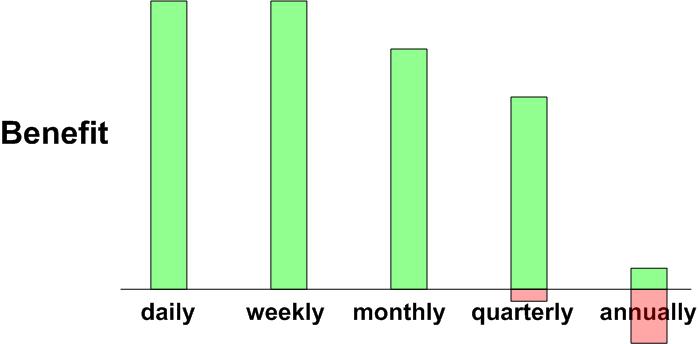The effects of three regimens of cholecalciferol (vitamin D3) supplementation on vitamin D deficiency in non-obese and obese females.
Arch Med Sci Atheroscler Dis. 2018 Mar 27;3:e60-e67. doi: 10.5114/amsad.2018.74784
Imga NN1, Berker D1, Can B1, Guler S1.
This study: Daily vs. Weekly 50,000 IU oral Vitamin D for 8 weeks---
Obese lost more weight on diet if added 50,000 IU of vitamin D weekly – many RCTs*
One pill every two weeks gives you all the vitamin D most adults need* Which includes "
32 health problems fought by 50,000 Vitamin D weekly "
A sampling of the many RCT which found weekly to work well (often 50,000 IU was used)*
50,000 IU of vitamin D weekly following cardiac failure helps – RCT 2014*
Depression in adolescent girls reduced somewhat by 50,000 IU weekly for 9 weeks – July 2017*
Irritable Bowel Syndrome treated by weekly 50,000 IU Vitamin D – RCT Feb 2019*
Peripheral diabetic neuropathy helped by weekly 50,000 IU vitamin D – Jan 2019*
Urgency Urinary Incontinence in senior black women decreased 40 percent by weekly 50,000 IU vitamin D – RCT Dec 2018*
Attention-Deficit Hyperactivity Disorder treated by weekly 50,000 IU of vitamin D – RCT Nov 2018*
Depression in seniors treated by weekly 50,000 IU of vitamin D – RCT Sept 2018*
Hashimoto's thyroiditis helped by weekly 50,000 IU of vitamin D – RCT May 2019*
Athletes helped by weekly 50,000 IU Vitamin D – RCT Aug 2019Weekly may be BETTER than daily*
Vitamin D dosing - weekly may be better than daily – video Aug 2018*
Weekly Vitamin D to mother after birth much better than daily - RCT Aug 2018---
Non weekly*
Monthly 100,000 IU of vitamin D is safe (and may be better than daily) – RCT Aug 2018*
Vitamin D update – 40-60 ng ideal, 50K biweekly maintenance – Jan 2014*
Pregnancies helped a lot by Vitamin D (injection then 50,000 IU monthly) – RCT May 2018*
100,000 IU of vitamin D monthly decreases use of NASIDs by 13 percent if low vitamin D – RCT May 2018*
Autism treated by Vitamin D (monthly injection of 150,000 IU) – June 2017*
Less bone loss if take 100,000 IU vitamin D monthly – RCT Nov 2017* * *
items in category
Intervention - non daily**
1 or 2 per month may be BETTER than daily*
50,000 IU of vitamin D every two weeks – Jordan conclusion - RCT July 2017* 50,000 every two weeks is slightly better than 100,000 once a month*
Vitamin D every 25 days may be BETTER than daily – RCT May 2018*
Monthly vitamin D dosing had higher response than 3 per month – RCT Jan 2018Take vitamin D3 daily, weekly, or bi-weekly has the following* Notional chart for Vitamin D supplementation for levels **< 30 nanograms**

* Notional chart of Vitamin D benefit vs dosing frequency for
> 50 nanograms 
{include}
📄 Download the PDF from Vitamin D Life

Note: vitamin D levels dropped by the 6th month asthere was no dosing after the 8th week
Vitamin D deficiency is a common health problem worldwide and tends to be a risk factor for all-cause mortality. We evaluated the effect of continuous low-dose oral daily and loading dose of oral weekly and loading monthly intramuscular (IM) vitamin D3 regimens on circulating levels of total 25(OH)D and in vitamin D deficient females, and between non-obese and obese subgroups.
MATERIAL AND METHODS:
A total of 231 vitamin D deficient females were included to the study. According to treatment regimen, patients were divided into three groups:
All patients in treatment groups were divided into non-obese (105) and obese (126) groups. Serum 25(OH)D and parathormone (PTH) levels were evaluated at baseline and at the third and sixth month.
RESULTS:
In obese patients oral weekly loading regimen and in non-obese patients oral daily continuous regimens were found to be more potent. Baseline PTH levels decreased when compared with the third and sixth months (p < 0.001), but between the third and sixth months it was not changed (p = 0.783).
CONCLUSIONS:
were more effective in achieving the target levels of 25(OH)D concentration above 30 ng/ml and provided a stable plasma vitamin D concentration over a long period of time.
Title was revised August 2019 causing the visitor count to reset.
There have actually been visitors to this page since it was originally made
 * Notional chart of Vitamin D benefit vs dosing frequency for > 50 nanograms
* Notional chart of Vitamin D benefit vs dosing frequency for > 50 nanograms  {include}
{include}
